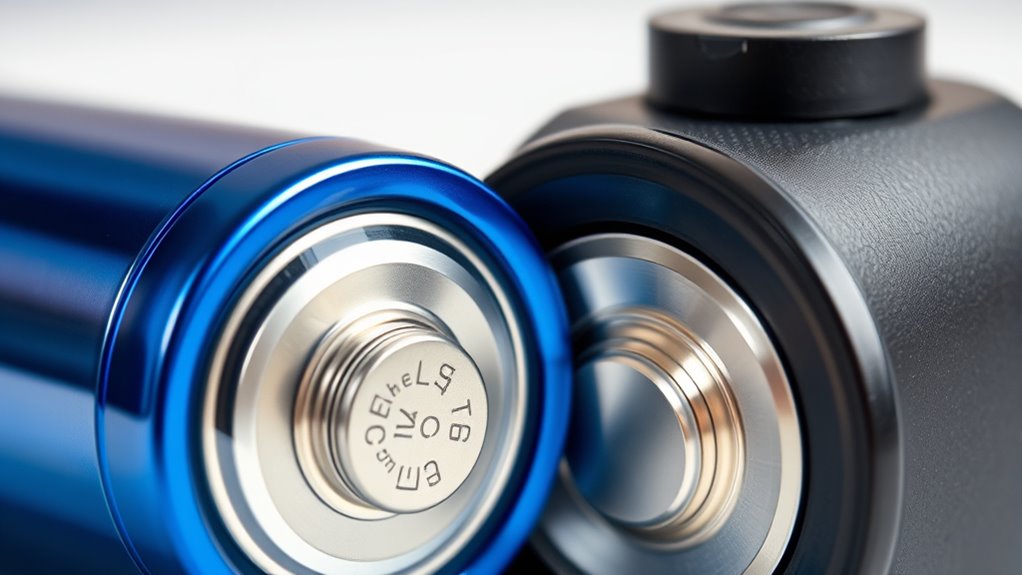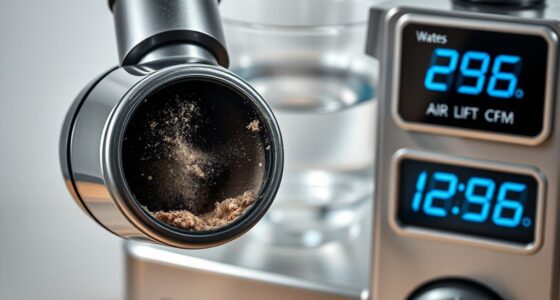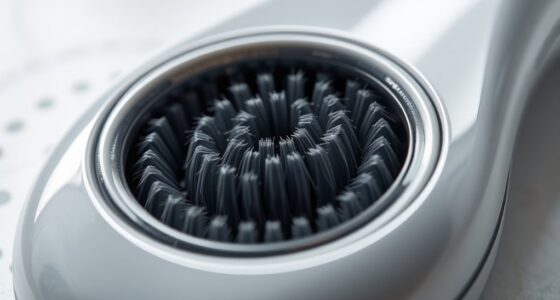Lithium-ion batteries offer higher energy density and longer runtimes, making them ideal for smartphones and electric vehicles, but they require careful thermal management for safety. NiMH batteries are more stable and safer, with simpler recycling processes, often used in household electronics and hybrid cars. If you want to understand how these chemistries differ in performance, safety, and environmental impact, keep exploring the details behind each type.
Key Takeaways
- Lithium-ion batteries have higher energy density, providing longer runtimes compared to NiMH.
- NiMH batteries are more thermally stable and safer, with less risk of overheating or fire.
- Recycling NiMH batteries is easier and more environmentally friendly than lithium-ion batteries.
- Lithium-ion batteries excel in high-demand applications like smartphones and electric vehicles.
- NiMH batteries are suitable for household electronics and hybrid vehicles due to their safety and robustness.

When choosing the appropriate battery for your device, understanding the differences between various chemistries is essential. Lithium-ion and nickel-metal hydride batteries are two common options, each with distinct advantages and limitations. Lithium-ion batteries are popular because they pack a high energy density, allowing devices to run longer on a single charge. They also perform well over many charge cycles, making them a reliable choice for smartphones, laptops, and electric vehicles. However, their thermal management becomes critical; if they overheat, they can degrade faster or, in rare cases, pose safety risks. Proper cooling systems are necessary to prevent thermal runaway, which can cause fires or damage the battery. Additionally, lithium-ion batteries present recycling challenges. Their complex chemistry makes recycling more difficult and costly, often leading to environmental concerns when they’re discarded improperly.
Lithium-ion batteries offer high energy density but require careful thermal management to ensure safety and longevity.
On the other hand, nickel-metal hydride (NiMH) batteries are known for being more robust and safer in terms of thermal stability. They tend to handle temperature fluctuations better, reducing the need for elaborate thermal management systems. This makes them suitable for applications like hybrid vehicles and certain household electronics, where safety and simplicity are priorities. NiMH batteries are generally less prone to overheating, and their chemistry allows for easier recycling, which reduces environmental impact. However, they have a lower energy density compared to lithium-ion batteries, meaning they don’t last as long on a single charge and tend to have shorter lifespans. This can be a drawback if you need a battery that holds power for extended periods or undergoes frequent charging cycles without significant capacity loss.
Another critical factor is the environmental footprint. Lithium-ion batteries, while offering better performance, pose greater recycling challenges due to their complex chemistry and the presence of rare materials like cobalt and lithium. Developing efficient recycling methods is ongoing, but these processes are often expensive and not yet widely available. NiMH batteries, in contrast, are more straightforward to recycle and contain fewer environmentally problematic elements, making them a more sustainable choice in some applications. Additionally, advances in battery chemistry are continuously improving the sustainability and safety profiles of both types.
Ultimately, your decision depends on your priorities: if you need high capacity and longer runtimes and are prepared to manage thermal issues, lithium-ion is usually the best pick. But if safety, ease of recycling, and stability are more important, nickel-metal hydride might suit you better. Knowing these distinctions helps you make informed choices, balancing performance with safety and environmental considerations.
Frequently Asked Questions
Which Battery Type Has a Longer Lifespan in Real-World Use?
You’ll find that battery longevity depends on how well you manage wear and tear over time. Generally, Nickel-Metal Hydride batteries tend to last longer in real-world use because they handle repeated charging cycles better. Lithium-ion batteries, while offering higher energy density, may experience faster wear and tear, reducing their lifespan. So, if durability is your priority, NIMH batteries often outperform lithium-ion in regarding long-term wear and tear resilience.
How Do Temperature Variations Affect Each Battery’s Performance?
Think of your batteries as delicate plants that thrive in the right climate. Temperature variations can turn their performance upside down. Lithium-ion batteries boast better thermal stability, handling temperature swings more gracefully, while nickel-metal hydride batteries are more temperature sensitive. Extreme heat accelerates degradation in both, but cold temperatures particularly reduce capacity and efficiency. To keep them running smoothly, avoid exposing your batteries to harsh temperature extremes.
Are There Environmental Concerns Associated With Disposing of These Batteries?
You should consider the environmental impact of battery disposal, as improper disposal can harm ecosystems. Lithium-ion batteries contain toxic chemicals and require careful recycling to prevent pollution. Nickel-metal hydride batteries also pose environmental risks if not disposed of properly, due to their nickel and hydrogen content. Proper battery disposal minimizes pollution, conserves resources, and reduces environmental hazards. Always follow local guidelines to guarantee safe recycling and disposal of these batteries.
Can These Batteries Be Recycled Effectively?
Imagine these batteries as treasure chests filled with valuable materials. You can open their potential through effective recycling processes, which focus on material recovery. By recycling, you prevent environmental harm and reclaim precious metals like lithium and nickel. While challenges exist, advancements make this process more efficient, ensuring you contribute to sustainability by giving these batteries a second life rather than disposal.
How Do Charging Times Compare Between Lithium-Ion and Nickel-Metal Hydride?
You’ll find that lithium-ion batteries generally charge faster than nickel-metal hydride ones because of their higher charging efficiency and better power output. Lithium-ion cells can handle rapid charging without degrading quickly, making them ideal for quick top-ups. Nickel-metal hydride batteries, on the other hand, require more time to charge fully and aren’t as efficient at high power output, so they take longer to reach full capacity.
Conclusion
Ultimately, choosing between lithium-ion and nickel-metal hydride batteries is like picking a guiding star or a sturdy anchor. Lithium-ion shines brightly with its energy and light-speed charge, symbolizing progress and innovation. Nickel-metal hydride, steady and reliable, offers a grounded, enduring strength. Your decision reflects whether you seek the luminous path of cutting-edge technology or the steady ground of proven resilience. Either way, your choice shapes the journey forward, illuminating your path like a beacon or anchoring it with steadfast resolve.









